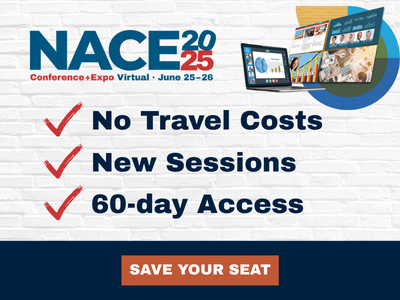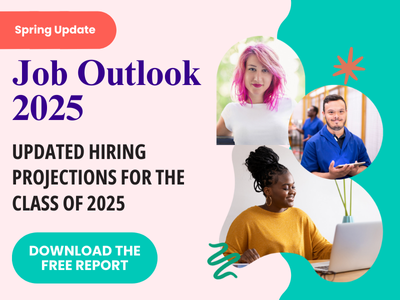Spotlight for Career Services Professionals
In this time of disruption and uncertainty caused by the coronavirus pandemic, when many career services practitioners are working from home, it is crucial for them to stay connected, says Tammy Spenziero, who is in a unique position to offer guidance on working remotely.
As director of career services at Excelsior College—a not-for-profit online institution—and NACE Group Leader for Online Career Services Professionals within the NACE Community, Spenziero is in a unique position to offer guidance on providing career services remotely.
First and foremost, she recommends ensuring that you have the right technology and are comfortable in your space at home by:
- Creating an environment around you that is conducive to your best work—This will inspire and motivate you. When you have a nice space free of clutter and distractions, it will allow your mind to also be clear and you will thrive.
- Taking breaks when needed—Get up and walk around, stretch mediate, listen to calming music or go outside for a brief walk to refresh and recharge. These things are often overlooked and we end up feeling burned out or overwhelmed. Get up and move around, have a healthy snack, and drink water throughout the day to keep your energy up.
- Not disconnecting—Connect with groups and gatherings to learn more outside of your remote work. Attend conferences and local events, and continue to learn and grow in your role to enhance services for students. Many of these groups, events, activities, and conferences are accessible remotely as well.
Another way Spenziero suggests to stay connected is to join groups of likeminded professionals, such as those in the affinity group for online career service professionals in the NACE Community.
“Share knowledge, tools, and resources to help one another so you can learn as well as bounce creative ideas off each other and work together to make them come to fruition,” she says.
“Seek knowledge, tools, and resources from those who have been doing it and are successful.”
Spenziero says that the major benefit of providing career services remotely is that with the right technology, practitioners can reach any student, anywhere regardless of their physical geographic location.
“A simple phone call or email works to connect and communicate,” she explains.
“However, now we have so much more virtual capability through platforms offering video chat, group chat, and even large-scale online events and activities. This allows us to provide our essential functions of career coaching and professional development services to a special population of students who otherwise would not be able to attend a traditional college.”
However, there are also challenges that arise, including accounting for time zones, technology malfunctions, learning curves with functions, and more.
“It can also be a challenge when a student is struggling with a virtual service or platform and they cannot seem to get the help they need to fix a bug, error, or problem they encounter,” Spenziero says.
“When you are not right there with them seeing what they are clicking on and struggling with, it can take a bit longer to troubleshoot and problem solve. However, with video capability, screen shots, and sharing virtually, issues get resolved. It may just take a bit longer to understand what they may be saying or doing.”
To avoid issues on your end when conducting a live event using virtual technology, be sure to fully understand the technology and test it several times.
“Have plenty of demos with the vendor and be sure they have excellent customer service and can help when needed,” Spenziero recommends.
“All too often, we have high hopes of amazing virtual events—such as job fairs and interviews—and then learn we did not allow ourselves enough time to understand it and give it a dry run, or even two or three.”
In terms of preparing others for virtual events, the ways in which career services practitioners can prepare their students and employers for virtual events does not differ much from the ways career services prepares them for in-person events, she says. Spenziero also suggests creating an on-demand video that includes tips and coaching as it relates to best practices in an online interview or during a virtual career fair.
“Maybe even demonstrate interactions with a colleague on your team so that the student can view and conceptualize the setting,” she adds.
“Allow your students to practice on their own and send you a recording to review and then provide feedback in a coaching setting. All the same rules apply for employers and students when conducting an online interview.”
These rules include being mindful of the setting and environment they are in, especially if via video.
“You want to ensure your background is minimal when you are on camera,” Spenziero advises.
“Have a neat, clean space free of distractions, and keep it professional and simple. It is common sense, but don’t be sitting in your bed with fluffy pillows in your PJs. Dress as you would in person, professionally, and sit in a location that is also professional, such as at your desk. You do not want to have too much noise, such as a barking dog, radio, or television if you can control it. There are some things that you cannot control, such as a siren driving by.”
There are effective tools available that students can use to mock interview, record themselves, hear it back, and obtain feedback to improve.
“You could provide example interviews for careers and you can even work with your alumni and others to create your own videos for demos and practice,” Spenziero suggests.
“The use of video allows students to observe body language, words, and filler words they may use, as well as the speed and tone at which they talk and how often they smile and make eye contact.”
She said there are other technologies that are particularly helpful in providing career services remotely:
- Virtual career/life coaching appointments—“Find a tool that allows your students to book an appointment online via your website directly. There are many vendors you may already use that have this function within their platform. Find what works best for you and your team of career coaches. You may have a calendar for appointments that everyone uses, and I suggest using a tool that allows you to sync calendars. This way, you can block time, create titles for your appointments, and allow students to select a reason for the appointment, and then add a note about their needs. You want to have the ability to communicate with them should there be anything you feel they should have prepared for your discussion. The student can leave you a note when they book their appointment and give you more insight into the reason they want to meet. If you want to approve every appointment, add that function or you may just want to allow students to freely book whenever there is an open slot available in a calendar. There are also options through which you can allow a student to select a specific counselor based on program areas or other functions that align with your operations. Allow for the ability to communicate via video, phone, or screen-share though an online link. Find a tool that you can customize based on your needs. Another consideration is a tool that can also be mobile friendly and has an app that is user friendly and efficient.”
- Online career development pathing—“I highly recommend online self-assessments of career competencies, values, and skills with the ability to provide feedback, suggestions, and reporting capabilities. One of the most important tasks we encourage all students to do at Excelsior is to create a career development plan. They are in college for a reason—to learn, achieve growth, change careers, or further their education. This is where you can get creative and provide tools and resources for your students online that assist them to plan, prepare, and accomplish goals. We are in the process of redesigning our career services website and will incorporate our own career and professional development path for students. The path will allow students to find their place based on where they are in their life and their career and professional development needs. Along this path we will provide the tools and resources [technology] they can use, with each falling into one of four phases: Discovery, Exploration, Planning, and Achieve & Accomplish.”
- Virtual micro-internships—“Excelsior connects students with internship opportunities with companies in various geographic locations and even in the federal government. These are short-term, paid professional projects that can be completed at a distance and can require anywhere from five to 40 hours of work any time during the year. This option benefits our students as well as employers in many ways. When students feel unprepared or lack experience before earning their degree or are career changers, this gives them opportunity for experiential learning. In addition, this allows our employer partners to offer opportunities to help their organizations without having to run a full-scale traditional summer internship program.”
- Online networking platforms—“E-portfolio platforms, as well as LinkedIn, are excellent for your students. Teach them how to use these and build a profile for connecting and sharing with others. There are many best practices out there for what you should put into an e-Portfolio as well as a LinkedIn profile. Create samples and/or an outline that you can share on your site with step-by-step instructions or even an on-demand video tutorial that shows students how to leverage these professional platforms to guide them in meeting their objectives.”
“Start thinking creatively and if something is not done remotely, try to look into ways to make it possible,” Spenziero recommends.
“Nothing is so far out of reach these days with ingenuity and sharing ideas, especially with all the technology we have. Meeting the needs of students is possible 100 percent full scale with career service professionals working remotely from any location for their institutions. We learn from others to follow best practices, use technology, test run programs and initiatives, and troubleshoot all of the possibilities to find what is most effective. If you think of an idea and need the help to make it come to fruition, do your research and connect with others who have done it or a variation of it to enhance or develop a service you can provide remotely.”
She adds that as humans, we do enjoy a hug or a handshake to express our happiness.
“You can’t do that through a computer,” Spenziero says.
“These days with COVID-19, there’s not much handshaking happening anyway. However, with technology, you can always send an emoji and share a real, genuine smile.”






